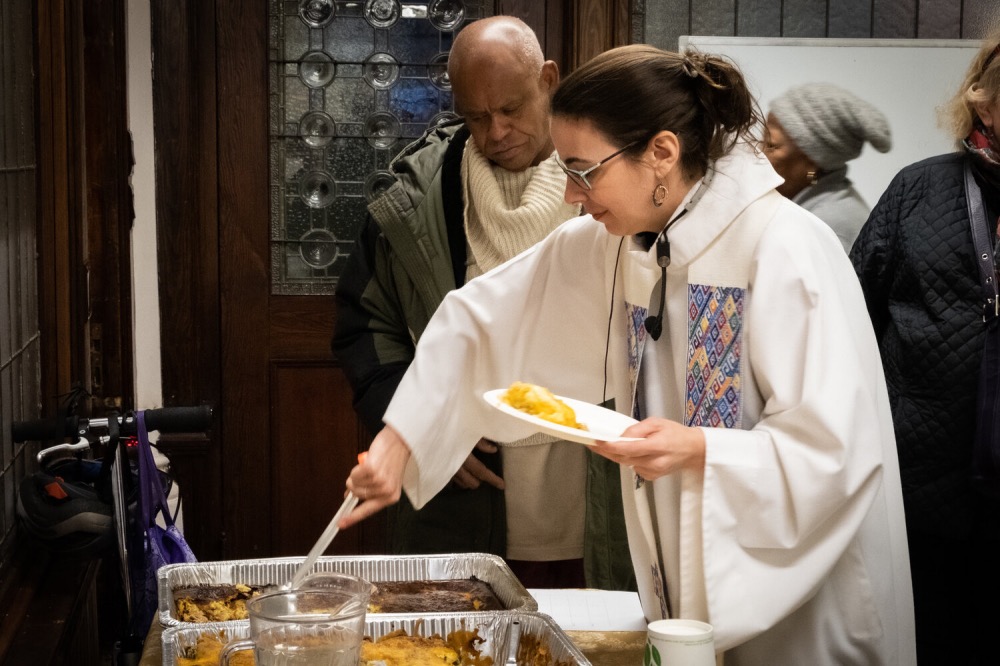
GEORGIA GEE, writing for Religion Unplugged, reports how New York’s Advent Lutheran Church came to be nick-named ‘The Eating Church’ and the challenges its programs face…
New York City, US
Religion Unplugged
On 93rd and Broadway in Manhattan, up the stairs and through the double doors, is a sanctuary lined with wooden pews and adorned with stained-glass windows. The main entrance of the Advent Lutheran Church offers a glimpse into a tranquil hub, on one of the busiest streets of the Upper West Side.
But many who frequent the church have never entered here. Through the side door, down the stairs and into the hall next to the kitchen, they come seeking food. Members of the church’s food ministry have started calling it “the church in the basement”.
“There are people who come here multiple times a month, but they never come up the stairs to the holy sanctuary,” said Cathy Carpenter, who has been a member of the church’s food ministry for over 20 years.

Pastor Danielle Miller dishes a plate of food for herself in the Advent Lutheran Church’s basement between services on Sunday. PICTURE: Gabby Miller.
Advent is one of 19 food pantries and soup kitchens in the neighbourhood, 11 of which are in churches, according to a 2019-2020 guide by Hunger Free NYC.
Now the church’s food pantry, which started in 1996, is feeding more people than ever. On the first Saturday morning of every month, they hand out an average 190 bags filled with canned goods serving 760 people. That’s double the 421 monthly average in 2018.
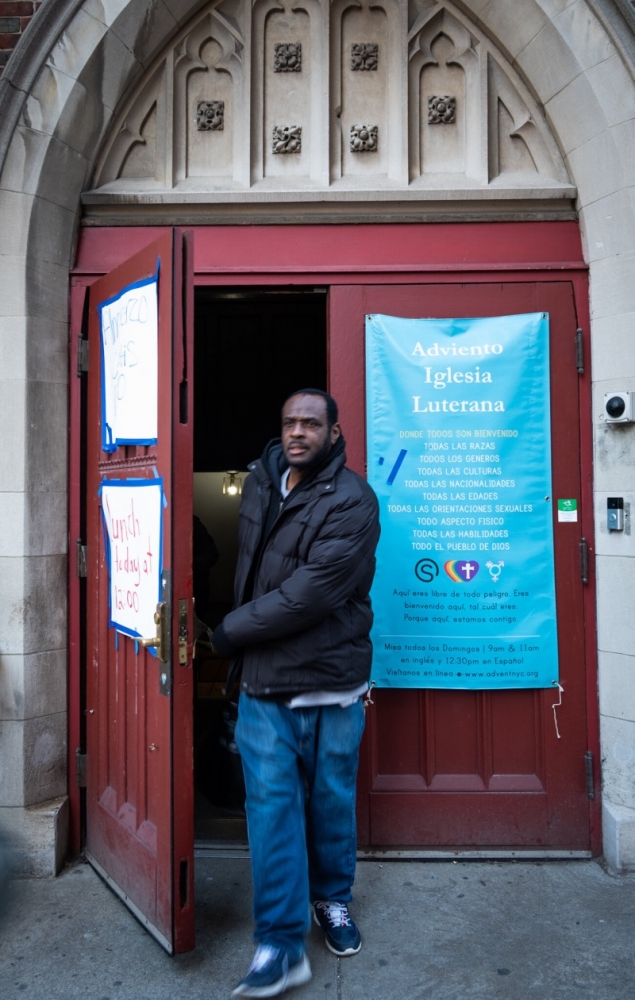
A man leaves the church after the monthly community lunch. The church puts up signs the weeks before and locals know by word of mouth. PICTURE: Gabby Miller.
“The invitation is always open. We want to make sure people feel they are truly welcome as soon as they step in.”
– Pastor Danielle Miller of New York’s Advent Lutheran Church.
One in eight New Yorkers are unable to afford adequate food, according to the non-profit Hunger Free America, the organisation supporting Hunger Free NYC. Although soup kitchens and food pantries used to serve only the homeless or unemployed, today many of the hungry are working class families who cannot afford enough groceries.
That’s partly due to wages not keeping up with rising housing costs. Between 1996 and 2017, New York City lost more than one million housing units costing less than $US800 per month, with low-rent apartments now just 17 per cent of the market.
The city’s food pantries, many of them run by faith-based organisations or churches, fed five per cent more people in 2018 than in 2017, compared to annual increases of six per cent in 2017, nine per cent in 2016 and five per cent in 2015, according to Hunger Free America. And although food security has increased over the past six years, it hasn’t returned to pre-recession levels of 2005-2007.
Concerns of safety and losing their spiritual mission
Food assistance has always been central to the church’s identity, according to Lorenza Darley who has been attending church every Sunday since 1958. “People used to call us the ‘eating church,’” she said. “We always had food and we continue in the same way: accepting people that come in from the street and never sending anyone away.”
Pastor Danielle Miller joined Advent two-and-a-half years ago and has continued to foster this atmosphere. “The invitation is always open,” she said. “We want to make sure people feel they are truly welcome as soon as they step in.”
There is no other agenda, the pastor added. It is about feeding bodies; not winning souls. “The act of feeding people, serving, is an act of prayer,” she said. “Our mission is love; it doesn’t feel particularly conflicted in that mission. Our struggle is how to meet the need.”
But as food insecurity increases and the homeless population grows, greater demands are being put on the congregation. Even people like Carpenter who volunteers at the food pantry, worry that the central religious message is getting lost. “Our vision is more than just food,” Carpenter said. “People know to come here for food, but they don’t know who we are as messengers of God.”
Walking past every day on my way uptown I had noticed there was always someone on the church’s steps; they were a little neighbourhood hub. Eventually I decided to venture inside, but the door was locked.
Two years ago, the church’s main doors, which used to remain open 24/7, were closed during the weekdays after a number of incidents. Two fights took place at night when people came to sleep, and a previous pastor was punched trying to break up an altercation. An office administrator at Advent was followed and harassed by a man who would linger outside, and someone was caught urinating on the altar.
The office administrator worries not only about the mission of the church, but also about personal safety. Locals often “don’t respect it as a temple,” the employee said. “They see it as a place for assistance.”
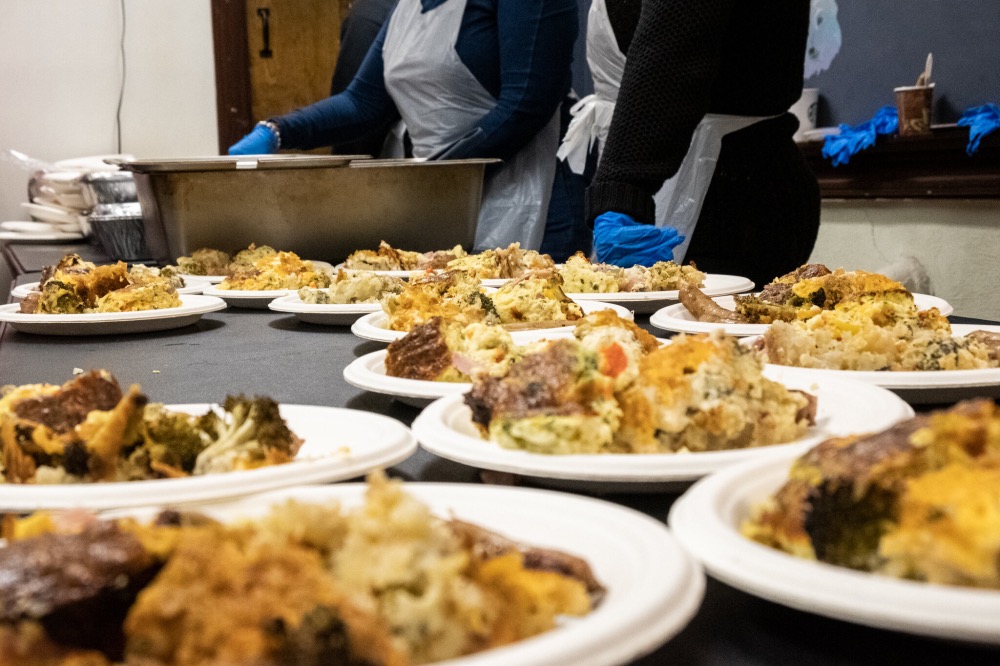
A roast meal at the community lunch. The church is nick-named “the eating church.” PICTURE: Gabby Miller.
Pantry running bare with influx of hungry
At 10am on a chilly November morning, the queue starts outside the door. Coloured shopping carts take over the sidewalk. Puffer jackets zipped up, those waiting perch impatiently on the rail muttering in English, Spanish and Mandarin. By 10:30am the line stretches around the block.
“It’s like clockwork. It’s always there,” said Frankie Thompkins, a consultant who has been running the food pantry for 14 years. “Even if it’s a holiday, we still do it no matter what.”
When the doors open, a volunteer directs the frantic traffic down the stairs. Trays of hot coffee and peanut butter sandwiches are on the side to grab whilst waiting. In the hall, two young girls sit behind a folding table on their parents’ lap counting the people that walk in. No ID is required; the only question asked is “how many are in your household?” The answer is noted, and a bulging plastic bag with “THANK YOU” printed on the front in big red letters is handed over from the next table.
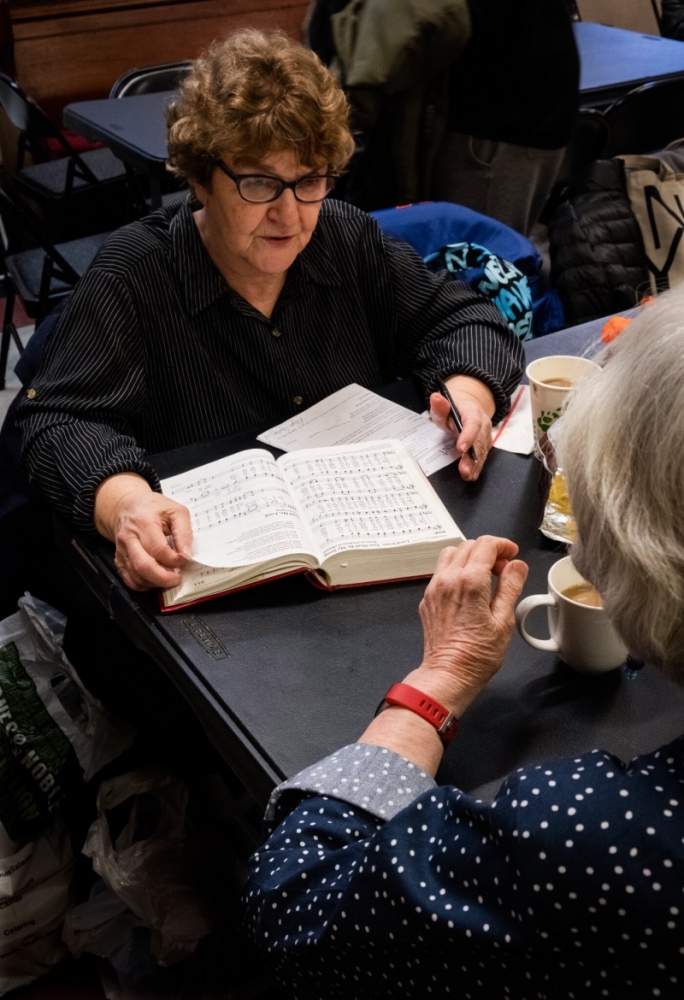
Cathy Carpenter at the coffee hour after Sunday morning services at Advent Lutheran Church. PICTURE: Gabby Miller.
In a checked fleece and black boots Thompkins stands by the door, hugging and catching up with the regulars. “There are people who have been coming for years, I’ve watched their kids grow up,” she said. “But there is also an influx of people, especially single local men, coming from nearby shelters.”
Next door the church is The Narragansett Hotel, a single room occupancy unit for low-income New Yorkers and specialised need populations, such as medically fragile people and recovering drug addicts. Residents are often seen hanging on the church’s steps during the day and many come to get their groceries at the food pantry. Behind the church is six public housing buildings.
There was a time when people could drop by in the week or take two bags on a Saturday. “Now they are lucky if they get one,” said Carpenter. “Our pantry is really bare right now.” The pantry isn’t advertised because the church fears it will not be able to provide more than it currently does. Locals know about it by word of mouth.
Once the line has filtered back outside bartering begins among the recipients: the pasta for the rice, the beans for the tuna. Shouts of “No eggs?!” echo down the street. The pantry ran out; Driscoll only delivered 60 boxes of the 180-dozen order. Delivery problems are common, and frustrating for both volunteers and attendees. Thompkins would have bought them herself in the supermarket had she had found out earlier. “Most people cook with eggs,” she said. “These are one of the most precious things for the people that come.”
Rising food prices, declining funds
The food pantry is not the only program provided by the church. There is a community lunch on the last weekend of every month and a “Trinity Advent dinner” which began a few years ago. The nearby Trinity School donates food and its students help serve. Each dinner attracts around 150 to 175 people but it’s unpredictable – anyone can show up. The clientele for these events is different from the pantry’s, a large amount are single elderly folks or those living in shelters who are unable to cook.
On the Saturday before Thanksgiving “The Senior Citizen Crew” – as they call themselves – are sat around a table in the corner of the hall at the community lunch in their Christmas jumpers. Pat, Frances and Ross live in local housing cooperatives. “You have to come here,” says Pat. The other two hummed and nodded. “The food is prepared with TLC.”
The coffee hours that take place after each service on a Sunday morning – two in English and one in Spanish – have also become a place for members to chat, and locals to get a hot meal. Home fries, eggs and hot drinks are set out in buffet style.
Every week, in his beret and checked shirt, Leeroy Tucker tops up the crackers and chats with members of the congregation. The woman next to cut him calls him “Big Daddy” as she cuts her bacon. Laura has been coming for breakfast every week for 28 years, but never goes upstairs. “I’ve met all of his [Tucker’s] family,” she tells me as she gets up to leave. “Oh, I am very full,” she mutters on her way out.
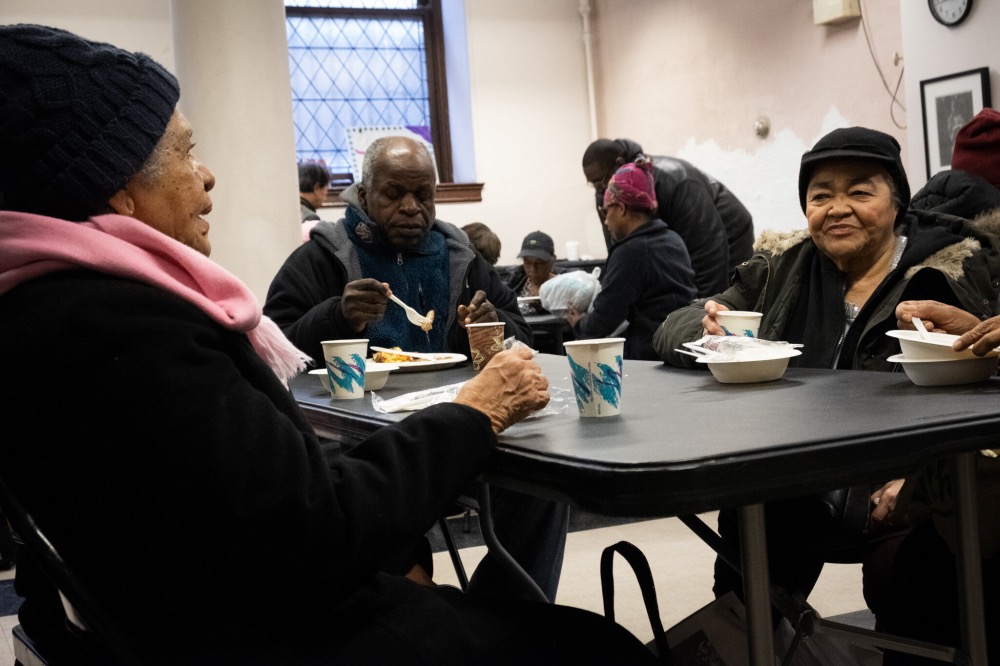
Patrons of a meal at Advent Lutheran Church. PICTURE: Gabby Miller.
Now the Sunday sexton, Tucker started the church’s food program in 1996 when he was the building’s full-time manager. He noticed that people were constantly knocking on the church doors for food, many coming from the local SROs.
“I said I need to start something,” Tucker recalled. “I didn’t call it the soup kitchen, I called it the lunch program. When people hear soup kitchen they go “ugh.”
Tucker began taking trips to the Bronx Terminal Market, buying huge rolls of ham and cheese for $US10. He would take them to get cut at the local butcher, and his aunt would provide bread from the bakery where she worked. Alongside a couple of volunteers, he would make sandwiches alongside a can of juice and a piece of fruit – whatever they had that he could afford. On Saturday mornings twice a month, Tucker would stand outside the church, “in sun, snow or rain,” handing out the bags to over 60 people, next to a large empty water jug for donations.
A couple of years later, the church received funding from United Way – a national non-profit that helps raise money for charitable organisations – allowing them to expand their programs. They formed a food ministry and began the food pantry and community lunch.
Now the church also receives food and funding from New York City’s Emergency Food Assistance Program, as well as discretionary funds from the City Council and donations from members of the congregation. But the United Way funding – which is held and divided up by the Lutheran social services – has gradually been cut to $US3,400 from $US6,000 back in 2004. The city food program just introduced a new online ordering system where the church can choose specific foods (previously it was delivered at any time with no choice), but the switch resulted in a dry spell over the summer. Their last major food delivery was in June, so the church had to turn to its cash reserve over the summer to run the programs.
“The lack of funds is greater than it ever was before,” said Thompkins. “And now we are helping more households, and food has gotten more expensive.”
“We really help people”
The drive for the next pantry begins the following week, and in the holiday season, the church expects even higher numbers. After its Sunday morning service, church members left their canned goods by the altar. It seemed to me an emblematic image of a church’s mission “to pray and to serve.”
“We really help people. And even when I’m on my vacation, my mind is always here.”
– Leeroy Tucker.
Whatever religious outreach is done; it is done subtly. At the community dinners, prayer cards are passed out. An announcement is often made at the start that members of the congregation will be stationed around for a conversation. But there is no mandatory Bible study. Pastor Danielle worked at food programs in Baltimore before she moved to New York. She found that the forced prayer at these meals was “horrific and manipulative.”
In Pastor Danielle’s office, I ask her how she feels about the overwhelming number of people who walk into the church but don’t participate. In 2019 alone, the food pantry and the community lunch have fed 8,411 people, more than 20 times the size of the congregation.
Pastor Danielle made the decision two years ago to shut the church’s doors because she wanted to create a “safe space” for employees or those seeking assistance: “We had to realise we don’t have all the resources a social service agency has,” she said. Instead, she has chosen to direct the church’s efforts to the food assistance programs.
The doors may remain closed during the week but both sets are open on the weekends: to the church upstairs and the “church in the basement.”
“We really help people,” Tucker said, sitting at the coffee table downstairs. He laughed, “And even when I’m on my vacation, my mind is always here.”
Georgia Gee is an investigative journalist and graduate student at Columbia Journalism School, with a particular interest in covering human rights issues. She moved to New York last year after attending University College London and working as a freelance journalist in the UK. Gabby Miller is a photojournalist and reporter at the Columbia Graduate School of Journalism.





